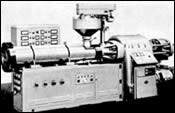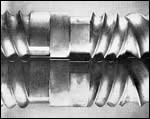No. 5 - Twin-Screw Extrusion
Twin-screw technology topped the experts’ lists as the most significant extrusion development of the past 50 years.
Share
Twin-screw technology topped the experts’ lists as the most significant extrusion development of the past 50 years. Commercial development dates to the late 1950s, but the ground-breaking work came 20 years earlier. Italian and German engineers developed the first twin-screw extruders, both co-rotating and counter-rotating, as a way to make PVC pipe more efficiently. Roberto Colombo, founder of LMP (Lavorazione Materie Plastiche) had first pursued twin-screws as a way to mix cellulose acetate without a solvent. In 1938 he thought of using an intermeshing, co-rotating twin-screw extruder to pelletize PVC for pipe extrusion. Until then, PVC pipe was made in sections with hydraulic presses.
Since that time, counter-rotating twin-screws have come to dominate rigid PVC extrusion. Twins permit high output at reduced shear rates, thus requiring lower levels of expensive stabilizers.
Twin-screws also compound and pelletize many resins as they come out of the reactor. They are widely used in general compounding with fillers and fibers and in reactive processing (polymerization, grafting, and resin modification). They are also used to produce most masterbatches and foams.
Co-rotating came first
LMP (acquired by Owens Corning in 1996) offered its first co-rotating extruders with either two or three screws of up to 109-mm diam. It obtained a patent in early 1939. One of its first customers that year was Germany’s I.G. Farbenindustrie, which first developed PVC.
After World War II, LMP licensed Creosot-Loire (now Clextral) in France, R.H. Windsor in the U.K., and Ikegai Iron Works in Japan to build twin-screw extruders. Toshiba Machine Co. became the first in Japan to build a fully intermeshing counter-rotating twin-screw in 1955.
Compounding machines with kneading disks mounted on co-rotating twin shafts also started during WWII at I.G. Farben. After the war the work continued at Bayer AG, which licensed Werner and Pfleiderer GmbH in 1957 to build the co-rotating compounders commercially under the ZSK name. Besides the kneading disks, another novelty in these twin-screw compounders—which later became an industry standard—was the use of short screw segments that could be replaced or interchanged for different processing requirements.
In 1981, Berstorff in Germany introduced a modular intermeshing, co-rotating twin-screw compounder with innovations in kneading discs and screw flights that reportedly improved distributive mixing by not being fully self-wiping. After W&P launched high-torque, high-speed co-rotating twins at K ’95, Berstorff also came out with high-torque models that have less free volume, higher torque, and higher shear capability.
Early counter-rotation
In 1940, Wilhelm Ellermann of Krupp developed what is claimed to be the first commercial intermeshing, counter-rotating twin-screw extruder, called the Knetwolf. Krupp patented it in 1941 and built units for I.G. Farben with screws up to 400 mm diam. The Knetwolf was taken over by Joseph Eck & Sohne Maschinenfabrik in Dusseldorf after the war, but it was discontinued when a more efficient compounder—the co-rotating kneader, was commercialized by W&P in the 1950s.
Carlo Pasquetti in Italy, who had worked with Colombo on the first co-rotating twin-screw, went in another direction and developed an intermeshing counter-rotating twin-screw extruder. Counter-rotating types turn more slowly than co-rotating and are more effective at pumping than mixing. They didn’t appear commercially to any great extent until around 1959 in Europe and 1969 in the U.S., largely thanks to the work of Anton and Wilhelm Anger.
In 1951-52, the Anger brothers used a parallel counter-rotating twin-screw extruder for rubber, built by Nouvelle Mapre SA in Luxembourg, but found it not very suitable for PVC pipe. In 1955, the brothers developed their first counter-rotating twin-screw extruder with three screw sections and 12:1 L/D. This is said to be the first extruder to process PVC powder directly into pipe.
By 1959, the Anger brothers were the largest PVC pipe maker in the world, with 30 extrusion lines. Their company, Kunststoffwerk Gebruder Anger GmbH in Munich, built twin-screw machines for their own use. In 1961, the Rheinstahl Group bought control of Gebruder Anger. The brothers had started another machinery company in Vienna in 1959, Anger Plastic Verarbeitungs Maschinenbau (APM) to build parallel, two-stage twin-screw extruders for commercial sale. In 1964, the brothers parted ways and Anton started Anton Anger Algemeine Maschinenbau (AGM) in Linz, Austria, where he claims to have built the first commercial conical twin-screw extruders.
Conical counter-rotating twins were developed to create wider centerline distance to allow room for larger drive bearings on small twin-screws. Small parallel models had bearings that were too small and didn’t hold up under load. Conicals are still the standard for small-to-medium-sized PVC lines today.
The first conical twin-screw extruders were imported to the U.S. in 1966 from Anton Anger’s AGM. In 1969, Cincinnati Milacron bought AGM and two years later also bought Wilhem Anger’s APM in Vienna and merged the two companies. (Today, Milacron builds both conical and parallel twins in the U.S. and sold its Austrian operation, which became Cincinnati Extrusion, part of SMS.)
The Pasquetti Company, which built 50-, 80- and 100-mm diam. counter-rotating twin-screw Bitruder machines, licensed the design to Schloemann Co. in Germany in 1960. In 1972, Reifenhauser bought Schloemann’s twin-screw technology and applied it to PS, PE, and foam. Reifenhauser supplies the Bitruder today for pipe, profile, and wood composites.
In the late 1950s Kestermann in Bad Oeynhausen, Germany, began building parallel counter-rotating twin-screw extruders. In 1970, Rheinstahl bought the Kestermann operation and merged it with the former Gebruder Anger, which ultimately became Battenfeld Extrusionstechnik.
Bausano in Italy began building counter-rotating twin-screws for PVC in 1946, first exporting them to the U.S. in 1965.
Paul Leistritz in Germany produced intermeshing twin-screw pumps for industrial fluids as far back as 1937 and built a few PVC machines after the war. It started producing counter-rotating twin-screw extruders on a regular basis in the late 1960s. It later made co-rotating compounders as well.
Welding Engineers (part of NFM since 1998) built non-intermeshing, counter-rotating twin-screws for diatomaceous earth in 1945 and made its first one for plastics in the early 1950s for Standard Oil Co. to pelletize PVC and PE.
Farrel Corp.’s Farrel Continuous Mixer (FCM) appeared in 1964 as an adaptation of its earlier Banbury Mixer. This counter-rotating compounder uses the same sort of “wing”-shaped mixing section as the Banbury batch mixer. Short wing-shaped mixing sections have been incorporated into twin-screw extruders from various suppliers, including Krauss-Maffei, Japan Steel Works, and Pomini of Italy.
In 1971, Krauss-Maffei formed an Extrusion Technik business unit and hired three former Anger engineers who developed and patented a “double conical” design for PVC in which the flight depth decreases from the feed zone to the metering zone. Together with a higher-torque motor, this design increased output.
One of those former Anger engineers, Horst Eigruber, founded Maplan in 1973 and briefly made pipe. Starting in 1976, Maplan patented and began to build another conical design. In 1998, Eigruber patented a double-conical that was the reverse of the Krauss-Maffei original—i.e., shallower flights in the feed zone and deeper ones in the metering zone. Eigruber says this version creates less shear at high output.
Read Next
Lead the Conversation, Change the Conversation
Coverage of single-use plastics can be both misleading and demoralizing. Here are 10 tips for changing the perception of the plastics industry at your company and in your community.
Read More

























